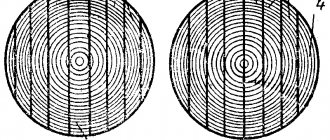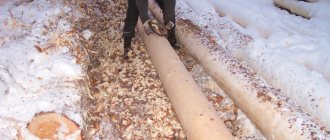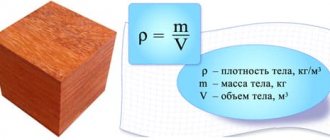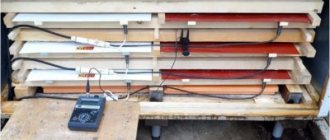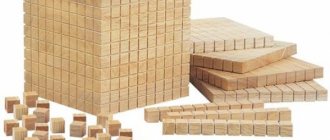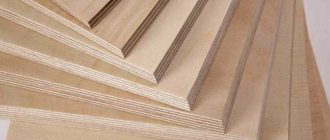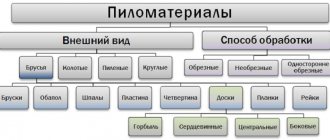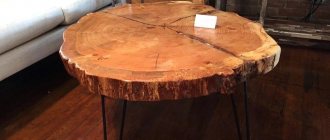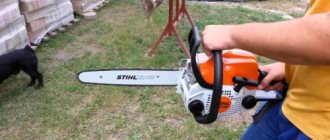A log is a tree trunk from which all branches, twigs and the thinnest upper part of the crown have been removed. It can be used as an independent building material (poles, piles, masts, etc.), as well as raw material for lumber.
Sawing logs into lumber occurs in various ways: manually using sawing tools, on sawmills, using machines and entire lines. The main emphasis is on obtaining a high-quality product with minimal production waste. The better it is cut, the more suitable lumber will be made from it. Large and even tree trunks provide, accordingly, the most valuable material. Before processing begins, you need to determine the thickness of the resulting boards. This is done in order to make maximum use of the entire volume of wood and reduce costs. The price of lumber mainly depends on its thickness. When sawing wood into thick beams, less waste is produced; accordingly, the cost of the product depends on the cutting done correctly.
Correctly selected equipment for sawing logs is half the battle:
- Chainsaws and ordinary hand saws are suitable for manual processing of trunks at home to obtain small quantities of lumber.
- A sawmill is a machine in which logs and beams are sawed; for this purpose, frame saws are installed in it. On such sawmill frames, trunks with a diameter of 14–80 cm and a length of 3 to 7 meters are sawn.
- A circular saw is a machine where tree trunks are cut using a circular saw. If there is one saw installed on it, then it is a single-saw machine; if there are several, it is a multi-saw machine. Single-saw machines are used for work in small shops and workshops where a large amount of material is not needed, while sawing logs on multi-saw circular saws is used for the production of large quantities of lumber.
- Band saws use a band blade mounted on pulleys to cut logs. With their help you can carry out longitudinal and mixed sawing of wood and various wood materials. They are widely used in carpentry shops and workshops and are distinguished by a large frame overhang, significant cutting height with small dimensions.
- Log sawing lines provide high quality product surfaces, precise geometry and high productivity, which is why they are used in the woodworking industry and large factories.
- Sawing logs with a chainsaw can be carried out immediately after felling a forest or cutting down trees. Such services are provided by companies that remove green spaces, and Derevoved is no exception. Our specialists provide services: they will cut down a tree on your site, cut it into components and remove all logging residues and wood debris. These events can be ordered as a group or individually.
Longitudinal sawing of logs
Before cutting the logs, the optimal method is chosen, which depends on the size of the required lumber, the desired surface quality of the boards, the type of wood and technical capabilities.
They start cutting only after inspecting the log, after which it is freed from bark and branches. If there are no flaws on the log, then processing is faster, and the lumber is of higher quality.
Cut the logs
Depending on the orientation of the growth rings, different types of log cutting are used:
- Radial view - the cut passes along the radius of the growth rings. They obtain high quality lumber that does not deform.
- Tangential view - the log is sawn tangentially to the growth rings. The lumber is of low strength.
- Parallel view - the cut runs parallel to the grain of the wood.
For sawing in the direction of the grain, the simplest method is a circular cut. First of all, the croaker is cut off. After this, the log is turned 180 degrees, and then the second slab is cut off. To obtain boards, the log is constantly turned.
For high-quality sawing of logs in different ways, the following general rules are used:
- so that the log does not move during processing, it is securely fixed;
- if sawing is done with a chainsaw, then use a chain for longitudinal processing. In order for the cut to be smooth and the saw not to be pulled to the side, the chain must be well sharpened and not sag;
- for sawing by hand, they try to select logs of short length;
- before sawing, the log is marked for a certain type of cut;
- sawing logs into boards begins with cutting the slab;
- Special attention is paid to safety measures at all stages of sawing logs.
Sawing logs is done on your own using various cutting tools.
Electric or gasoline saws
A gasoline saw has advantages over an electric model:
- the workplace is not connected to a power source;
- higher power;
- thanks to soft start and speed control, the risk of saw chain breakage is reduced;
- continuous operation for up to an hour, there is no need to interrupt the cut to allow the saw to cool down;
- You can work in any humidity, for example during rain.
Mini disc sawmill
One or two disks separated by an insert are used as a cutting element.
This sawing machine is widely used because of its advantages:
- simple design, equipped with an electric or gasoline engine;
- easy to use;
- accuracy of cutting logs according to marks;
- high productivity when sawing logs.
The main requirement for a circular saw is a durable frame and a powerful engine.
The peculiarity of independent longitudinal cutting of a log is clearly visible in four simple methods.
Introduction
This parameter is one of the most important indicators in sawmilling. The efficiency of sawing timber depends on this indicator. Many beginners mistakenly believe that the higher this ratio, the better.
In fact, this is not always the case; most specialists know about this, but remain silent. I repeat once again - a high percentage of lumber yield per cubic meter of forest is not always good.
I described in detail why this is so in my book “Organization of sawmilling at a modern enterprise,” but for readers I will lift the veil on this issue at the end of the article.
This is a truly unique e-book, there are definitely no such books in Russia :-)!!! It provides simply colossal information gained from personal experience as a technologist in a large production.
Cutting logs with a chainsaw into boards with a device
When you need to cut a log lengthwise with a low-power chainsaw, you cannot do without special equipment and skills. This is how the YouTube channel Do-it-yourself carpentry .
Logs for cutting
The basis of a homemade cutting device is a carriage, which is welded from a 25 mm profile pipe. Two guide pipes with a cross section of 30 mm are welded to the carriage. To fix the carriage in height, two M8 bolts are installed on each pipe.
Carriage with guides
The moving part of the device is T-shaped. It is also made from 25 mm profile pipe. Each rack has clamps that secure the chainsaw bar.
Stands with clamps
To ensure that the chainsaw chain moves freely, metal jaws 4 mm thick and 40 mm in size are welded inside the clamps.
Jaws in a clamp
When cutting, the carriage should move easily along the guides, so rollers are attached from below in all corners. We need inexpensive furniture casters made of plastic.
Carriage with rollers
Before installation on the guides, the device is assembled.
Assembled device
One section of an aluminum ladder is used as a guide for the carriage. The carriage is installed on top of the stairs, and thanks to the rollers it easily moves along the guides.
Carriage on the stairs
The device is designed to work with a Husqvarna 555 chainsaw with a power of 3.1 kW.
Saw Husqvarna 555
For longitudinal cutting, a special chain is selected. It differs in the pitch of the links and the sharpening angle of the cutting edge. The chainsaw sprocket is selected to match the pitch of the links.
Comparison of rip saw chain
The depth of the log cut depends on the size of the tire. Husqvarna does not produce tires with an optimal length of 55 cm, so they purchase a Partner tire and select a chain with 68 links for it.
Saw guide Partner
To operate, the device is mounted on a chainsaw. First of all, put the racks on the tire and secure them. Then the carriage is put on the racks.
Saw with attachment installed
The ladder is secured to the log using brackets and planks.
Ladder fastening
After installing the chainsaw with the device on the stairs, select the size of the cut and use this size to set the height of the carriage on the guides.
Setting the cutting size
The cutting occurs by moving a carriage with a chainsaw along the guides along the log.
Log sawing
Video about how to cut a log into boards with a chainsaw with a device:
Approximate yield by variety
The situation regarding varieties is quite interesting. It turns out that the percentage of yield of high-grade products depends on the following factors:
- The coefficient of production of lumber from round timber. Grade depends not directly, but indirectly. The fact is that after some golden mean, the more planks we get per cubic meter, the higher the amount of low-grade wood with wane;
- The larger the diameter, the higher the likelihood of getting more high-quality boards;
- The presence of wood defects, such as curvature, rot, blueness and others; the fewer there are, the higher the percentage of obtaining a high-quality board;
- The shorter the finished product, the higher the percentage of high-quality boards.
Now let’s estimate, approximately based on the diameter, the percentage of first-class lumber obtained from the total volume of boards produced. To do this, I made everything in the form of a small table.
Table 1 - yield of boards when sawing round timber
| Diameter, cm | Yield of premium grades, % |
| 12 — 16 | first grade yield 40% |
| 18 — 22 | on average 50% |
| 24 — 26 | about 50% |
| 28 — 40 | log timber, during the production of timber you can get indicators of about 70% |
| 42 — 60 | about 60 - 70% |
Cutting logs into boards with a chainsaw with a wooden guide
According to the host of the YouTube channel Advocate Egorov , this method is most suitable for plots where there are fallen trees. To cut logs, it is enough to have a medium-power chainsaw with a short bar and two planed boards. The boards are twisted end to end with self-tapping screws, and the resulting rectangular structure is reinforced with rectangular bars for rigidity.
Log prepared for cutting
The cutting of logs begins with the removal of a small slab. To ensure an even cut, a corner is attached to the log, which is used as a guide.
Installing a corner on a log
The log is turned over, and the guide angle is again fixed on the cut. For ease of installation, a support is installed.
Guide angle with support
The thickness of the resulting lumber depends on the installation height of the guide angle.
Cutting the second slab on a log
After cutting two slabs, full boards are obtained. If the log is long and the board pinches the blade when cutting, then wedges are inserted.
When cutting a long log, you need to monitor the heat of the saw and stop to allow the tool to cool.
Sawing logs along a guide
After cutting the logs in this way, boards of different qualities and different thicknesses are obtained.
Log sawn into planks
Video about how to cut a log into boards with a chainsaw with a wooden guide:
Percentage of round timber
Calculated using the formula:
Kout=Vpil/Vbr
Where K , % is the percentage of lumber yield.
Vpil , m3 - volume of lumber obtained. Calculated:
Vpil = L*H*B*n1+L*H*B*n2 + …
- where L is the nominal length of the finished lumber;
- H - board thickness;
- B - board width;
- n is the number of boards of each size.
Vbr , m3 - volume of logs from which lumber is obtained. Determined by the cubature, which can be.
The useful percentage of lumber in production is calculated for each diameter of the forest and for each sawing technology.
I can only give general recommendations, and improvements need to be done in specific places.
Cutting logs into boards with a chainsaw according to the marks
As shown in the video of the YouTube channel “ Glukhari. The second channel , “before cutting in this way, the log is cleared of bark, laid on spacers and secured with two screws.
Fastening logs with screws
Markings are made using a level. Two vertical lines are applied at the ends of the log.
Marking the end of the log
According to the markings, stretch the marking cord or place marks, and then connect them with a ruler.
Using a marking line
Marking a log with a ruler
The first cut of the log is made according to the markings.
First sawed log
In-depth cut of a log
Final cut of the log
Before the last pass, a noose is put on the log for belay, only after that the fastening screws are removed.
Removing mounting screws
Log sawn into two parts
Video on how to cut a log with a chainsaw according to the marks:
About programs for cutting round timber
Dear readers, I would like to add that today I have not seen any worthwhile paid programs made in Russia and sold separately on the market for sawing forests into lumber.
We're not talking about free programs. If someone has a different opinion, write in the comments, share, perhaps our view will change too! The main reason for this is the fact that this direction has just begun to develop. We hope that in a couple of years a good and worthwhile product will appear. Among domestic programs it is worth noting
I would like to add that modern sawmill lines such as “SAB” already have built-in programs for calculating deliveries. The 3D frames installed on the line give a signal for the optimal orientation of the log and the log unfolds using special mechanisms. At this time, the cutting saws are set to the size that comes to the machine from the computer.
Further processing of wood obtained from sawmilling is also important. That’s why the expression “total wood recycling” is so fashionable now. Often, wood chips, sawdust and slabs are burned in boiler houses to produce heat for production needs. At some European enterprises, not even “horns and legs” remain from the log.
